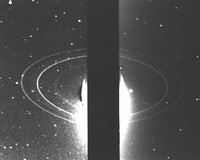Facts about Neptune

A portion of the dwarf planet Pluto's highly eccentric orbit brings it nearer to the Sun than Neptune, which has a nearly circular orbit.
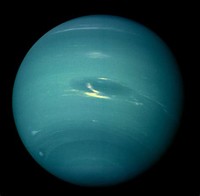
The closest approach of Voyager 2 to Neptune occurred on August 25, 1989.

Neptune is very cold, with temperatures as low as -224 °C (-372 °F or 49 K) recorded at the cloud tops in 1989.

Discovered on September 23, 1846, Neptune is notable for being the first planet discovered based on mathematical prediction rather than regular observations.
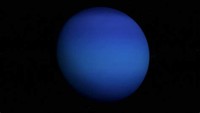
Uranus is visually quite bland, while Neptune's high winds come with notable weather phenomena.

Orbiting so far from the sun, Neptune receives very little heat with the uppermost regions of the atmosphere at ?218 °C (55 K).

Neptune's center is about 7,000 °C (13,000 °F), however—hotter than the surface of the sun.

The pressure at the center of Neptune is millions of times more than that on the surface of Earth.
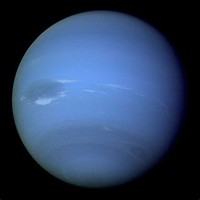
At 1.0243Ч1026 kilograms, Neptune is an intermediate body between Earth and the largest gas giants: it is seventeen Earth masses but just one-eighteenth the mass of Jupiter.
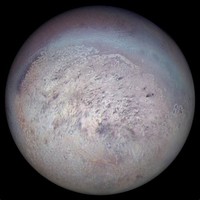
Neptune's largest moon, Triton, is notable for its retrograde orbit, extreme cold (38 K), and extremely tenuous (14 microbar) nitrogen/methane atmosphere.

Rather than seeing slower winds, the scientists found faster winds (over 1,600 kilometers per hour) on more distant Neptune.

Perturbations in the orbit of Uranus led astronomers to deduce Neptune's existence.
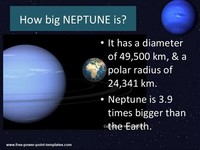
Neptune turned out to have the strongest winds of all the solar system's gas giants.
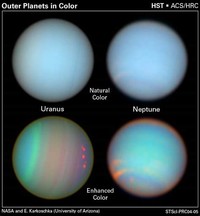
One difference between Neptune and Uranus is the level of meteorological activity.

Neptune's temperature at its cloud tops is usually close to ?210 °C (?346 °F), one of the coldest in the solar system, due to its long distance from the sun.

Nonetheless, Neptune radiates more energy than it receives from the Sun, and the internal energy source of these winds remains undetermined.

Neptune's atmosphere is primarily composed of hydrogen and helium, with traces of methane that account for the planet's blue appearance.
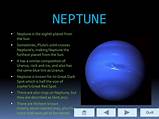
On Neptune, however, there is so little solar energy that once winds are started they probably meet very little resistance, and are able to maintain extremely high velocities.
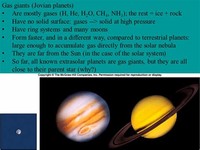
The largest by far, and the only one massive enough to be spheroidal, is Triton, discovered by William Lassell just 17 days after the discovery of Neptune itself.

In 2003, there was a proposal to NASA's "Vision Missions Studies" to implement a "Neptune Orbiter with Probes" mission that does Cassini-level science without fission-based electric power or propulsion.

At the time of his first observation in December 1612, because it was only beginning its yearly retrograde cycle, Neptune's motion was far too slight to be detected with Galileo's small telescope.
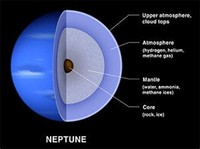
Meanwhile, on separate and independent occasions, Adams suggested altering the name Georgian to Uranus, while Leverrier (through the Board of Longitude) suggested Neptune for the new planet.

The new observations appear to throw our understanding of Neptune's rings into considerable confusion.

New Earth-based observations announced in 2005 appeared to show that Neptune's rings are much more unstable than previously thought.
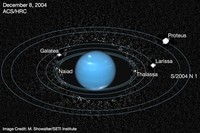
Neptune's innermost four moons, Naiad, Thalassa, Despina, and Galatea, orbit close enough to be within Neptune's rings.
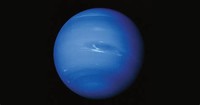
Neptune was discovered that very night, September 23, 1846, within one degree of where Le Verrier had predicted it to be, and about 10 degrees from Adams' prediction.

Like all planets and asteroids in the solar system beyond Earth, Neptune undergoes retrogradation at certain points during its synodic period.

Neptune also has the strongest winds of any planet in the solar system, measured to be as high as 2,100 kilometers per hour or 1,300 miles per hour.

A telescope or strong binoculars will resolve Neptune as a small blue-green disk, similar in appearance to Uranus; the blue-green color comes from the methane in its atmosphere.

Shortly after its discovery, Neptune was referred to simply as "the planet exterior to Uranus" or as "Le Verrier's planet."

Neptune's second known satellite (by order of distance), the irregular moon Nereid, has one of the most eccentric orbits of any satellite in the solar system.
It possesses nearly 58 times the volume of planet Earth. This means 58 Earths could fit inside Uranus if it were hollow. Neptune is 17 times as massive as Earth and has 15 times its surface area.
Despite being smaller than Uranus, Neptune has a greater mass. Below its heavy atmosphere, Uranus is made of layers of hydrogen, helium, and methane gases. They enclose a layer of water, ammonia and methane ice. The inner core of the planet is made of rock.
According to "Neptune: The Other Blue Planet in Our Solar System" (Choi, 2010), Neptune, despite its great distance from the sun, is the windiest planet in the solar system, with winds reaching 2000km/h (1500 mph) as detected by the Voyager 2 probe in 1989.Sep 25, 2013
Facts about NeptuneIt takes Neptune 164.8 Earth years to orbit the Sun. ... Neptune was discovered by Jean Joseph Le Verrier. ... Neptune is the Roman God of the Sea. ... Neptune has the second largest gravity of any planet in the solar system – second only to Jupiter.More items...
The core accretion model. Approximately 4.6 billion years ago, the solar system was a cloud of dust and gas known as a solar nebula. Gravity collapsed the material in on itself as it began to spin, forming the sun in the center of the nebula. With the rise of the sun, the remaining material began to clump together.Dec 14, 2016
As the planets in our Solar System get further away from the Sun, they generally get colder. So what is the coldest planet of our Solar System. That would be Neptune, the 8th and final planet in the Solar System. If Pluto was still a planet, it would be colder, but now it's Neptune.Jul 21, 2015
These were the only planets that were bright enough for them to see. Later, when telescopes were used, other planets were discovered. Astronomers decided to continue naming the planets after Roman Gods. Neptune, a blueish planet, was named after the Roman god of the sea.
Neptune was supposedly discovered in 1846 by Johann Gottfried Galle using calculations by Urbain Le Verrier and John Couch Adams, making it a joint British-French-German discovery. But these astronomers were not the first to observe Neptune. That honor goes to the famous Italian astronomer Galileo Galilei.Aug 28, 2014
Urbain Le Verrier, who discovered the planet, claimed the right to name his discovery: Neptune. Soon Neptune became the internationally accepted name. In roman mythology, Neptune was the god of the sea.Mar 12, 2012
Neptune was formed at the same time as the rest of the Solar System, from a large spinning disk of gas and dust. Astronomers think that all this happened about 4.6 billion years ago! So Neptune is about 4.6 billion years old.
Neptune Facts. Neptune is the eighth planet from the Sun and last of the known planets. While it is the third largest planet with respect to mass, it is only the fourth largest in terms of diameter. Due to its blue coloration, Neptune was named after the Roman god of the Sea.
While living on Neptune's moon Triton, you'd be subjected to the coldest temperatures in the solar system, incredibly weak gravity and retrograde sunrises and sunsets. ... Neptune, like the other gas giants in our solar system, doesn't have much of a solid surface to live on.Mar 24, 2015
It is also unique in being the only large moon in the solar system to circle its planet in a direction opposite to its planet's rotation — this "retrograde orbit" suggests that Triton may once have been a dwarf planet that Neptune captured rather than forming in place, according to NASA.May 12, 2017
In the paper, Orton and his colleagues report that the temperature at Neptune's south pole is hotter than anywhere else on the planet by about 10 degrees Celsius (18 degrees Fahrenheit). The average temperature on Neptune is about minus 200 degrees Celsius (minus 392 degrees Fahrenheit).Sep 18, 2007
It depends upon how you define "coldest." With Pluto out of the race, the farthest "real" planet from the Sun is Neptune. Neptune and its neighbor, Uranus, are known as the "ice giants," since they are composed of huge amounts of rock and water, ammonia, and methane ice crystals.
With minimum atmospheric temperature of -224°C Uranus is nearly coldest planet in the solar system. While Neptune doesn't get as cold as Uranus it is on average colder. The upper atmosphere of Uranus is covered by a methane haze which hides the storms that take place in the cloud decks.
This gives the rest of the atmosphere more of a chance to scatter light, just like the Earth's atmosphere does. Uranus: pale blue. ... As in the case of Uranus, the color is due to methane. Neptune would appear darker than Uranus due to dimmer illumination (greater distance from the Sun).Feb 7, 2016
